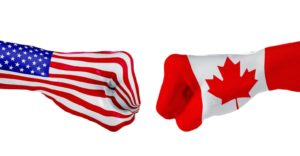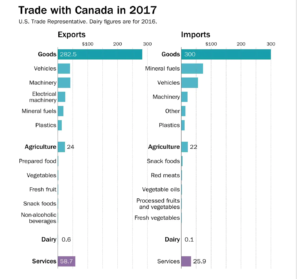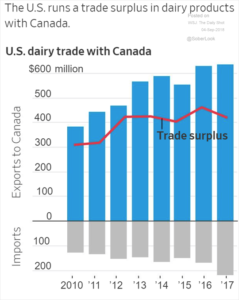(Editor Note: Insight Bytes focus on key economic issues and solutions for all of us, on Thursdays we spotlight in more depth Solutions to issues we have identified. Fridays we focus on how to build the Common Good. Please right click on images to see them larger in a separate tab. Click on the Index Topic Name at the beginning of each post to see more posts on that topic on PC or Laptop.)

Image: Feedstuffs.com
The U.S. actually runs a small trade surplus, of $8.4 billion with Canada when services are included. The GOP Administrations seems to miss this point in the present trade discussions even though 75 % of the U.S. economy is services based.

Source: Washington Post, 6/11/18
Note the U.S. exports about two and one-half more services to Canada than we import. The American surplus in agriculture products is $2 billion. It seems that just looking at the diary market taken out of the context of the whole trade relationship is a near sighted way to look a trade policy.
Looking at the specifics of dairy imports and exports reveals a trade surplus of $418 million here as well. In 2017, U.S. exported a total of $637 million of milk, cheese and other dairy products to Canada. Canada to protect its much smaller dairy industry has established a supply management tariff system.

Source: The Wall Street Journal, The Daily Shot – 9/4/18
POTUS has been quite focused on the supply management trade of dairy products declaring a provision for 270 % diary tariffs are outrageous. We examined how the supply management system works in a previous post,
“The reason there is a 270 % tariff on dairy powder is a system of supply management that was agreed upon by the US and Canada. For most dairy products sold within the quota of US imports into Canada a tariff of 7.5 % is applied by the Canadian government. When imports exceed the supply management quotas, super charges go into effect on products like dairy powder or over quota milk at 241 %. Canada has established a supply management system with the US on dairy products, as most countries including the US subsidize their dairy industry.”
Next Steps:
The GOP Administration needs to understand the history of Canada – U.S. trade relationship and work with the Canadian government as partners not with ‘whack-mole” intimidation. By making a deal with Mexico first and leaving Canada out, the President is holding Canada hostage to get to a deal done while pushing on Canada to give the U.S. diary industry an ever bigger share of the Canadian dairy market. Is this U.S. position fair?
We outlined our ideas on how to proceed in this way:
“First, our President needs to treat our long-time ally to the north as an ally and friend to the American people with respect, dignity and cordial public discourse. Privately, he may have disagreements, and negotiations should proceed to overcome trade imbalances where appropriate and to protect American jobs.
Second, the facts need to be used, not falsehoods as POTUS admitted in his first meeting with Trudeau, that he made up the idea there was an imbalance or equality or he didn’t know. It is time to do the homework, research the facts in our relationship, preserve the on-going huge amount of commerce we already do, and figure out how to work more closely together as partners not adversaries.”
Unfortunately, since June the trade rhetoric between the two countries has only grown more antagonistic mostly from the U.S. side. Canadian trade negotiator, Chrystia Freeland in a press conference last week before flying back to Canada, kept very calm, did not try to negotiate in public, would not enter into a tit-for-tat battle with POTUS and showed a high level of professionalism and respect. We can only hope that our representatives will recognize how to treat our long time northern ally from her example.
